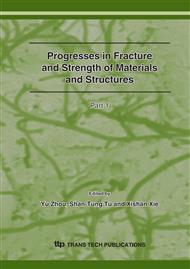p.1082
p.1086
p.1090
p.1094
p.1098
p.1102
p.1106
p.1110
p.1117
Numerical Investigation on the Fracture Behaviors of Three-Dimensional Functionally Graded Materials
Abstract:
Functionally graded materials (FGMs) with continuous varying properties have absorbed great attention for the purpose of eliminating the mismatch of material properties which may result in cracking. In this paper, three-dimensional finite element method (3D FEM) based on nonhomogeneous elements is used to study the fracture behaviors of a 3D FGM plate. Since real material properties at Gaussian integration points are adopted during forming the element stiffness matrix, the nonhomogeneous material properties can be applied in each element. Moreover, 20-node singular elements are used around the crack front to deal with the singularity of stress fields at the crack front. By this way, the stress intensity factors (SIFs) can be calculated with high efficiency and accuracy. Therefore, compared with the general FEM using homogeneouos elements, the calculating efficiency and accuracy can be increased. Finally, parameter analysis is conducted. It is found that the material nonhomogeneity constant and the crack parameter have significant influences on the SIFs.
Info:
Periodical:
Pages:
1098-1101
Citation:
Online since:
September 2007
Authors:
Price:
Сopyright:
© 2007 Trans Tech Publications Ltd. All Rights Reserved
Share:
Citation:


